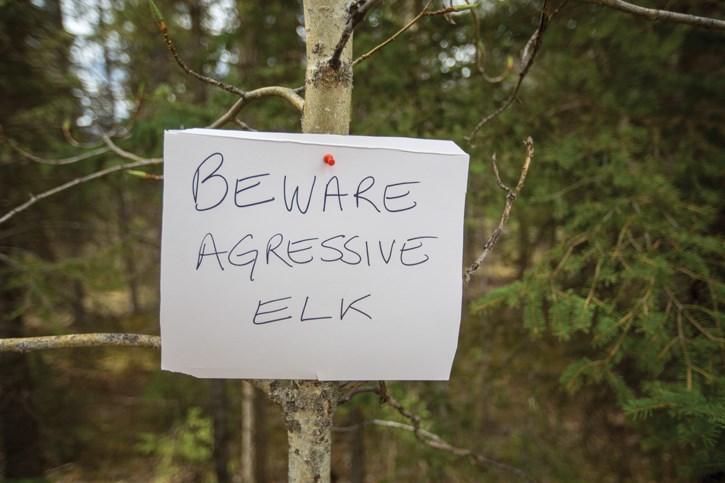BOW VALLEY – For the first time, an area on the west slope of Tunnel Mountain in Banff has been closed to provide security for female elk to give birth and tend to their calves.
The elk calving season, which typically runs mid-May until the end of June, is a time of year when protective mother elk will aggressively protect their newborns, leading to several attacks on people over the years.
Parks Canada officials say areas on the west slopes of Tunnel Mountain, including The Banff Centre, historically have been important calving grounds for elk, noting wildlife specialists have relocated elk frequently over the years to avoid dangerous encounters with people.
“The goal here is to provide that habitat security and hopefully elk will sort of gravitate to the lack of human presence as a calving area,” said Bill Hunt, resource conservation manager for Banff National Park.
“It’s in line with the idea of being proactive rather than reactive, rather than trying to respond to things in and around The Banff Centre, St. Julien Road and Surprise Corner where we’ve had concerns in the past.”
The closure, which runs until June 30, applies to the west slopes of Tunnel Mountain, south of the Tunnel Mountain Trail. It does not include the grounds of The Banff Centre but takes in surrounding areas.
All official trails in the surrounding area, including Tunnel Mountain Trail, Surprise Corner and the Bow River Trail remain open. Climbing access to the Black Band and Gonda Roof is permitted as climber can comply with the closure by using a descent from Gonda Roof routes.
Hunt said he is aware of at least two cows so far that have given birth to calves in the closed area, adding wildlife specialists also relocated a cow and her calf from east side of The Banff Centre into the closed area.
“We were able to do a scoop and run of a recently dropped calf into the closed area and have the cow follow,” said Hunt. “It was just a short trip across the road and was very successful.”
In the Bow Valley, several people have been injured over the years for getting too close to mother elk, which defend their newborn calves by charging or striking out with sharp hooves if they think that their young ones are in danger.
Elk should not be mistaken for tame animals just because they’re in residential areas of towns, on golf courses or recreation fields where they seek refuge to avoid predators like bears, cougars, wolves and coyotes.
Throughout the Banff townsite, elk are hazed to push them to the periphery of town.
“The key thing for this time of year is to make sure calving does not occur in town because we know that that brings carnivores into town,” said Hunt.
“Elk calves are an important food source for bears and even wolves and coyotes at this time of year, and so we don’t want that to be occurring in town, where it leads to other problems and conflicts.”
In neighbouring Canmore, Alberta Environment and Parks issued a warning after an aggressive cow elk, which dropped her calf just off the main trail behind the 1000 Larch Crescent cul-de-sac, was charging people on Wednesday evening (May 22) .
“I was just walking my dog behind my home and I noticed an elk on the other side of the walking trail,” said resident Lisa de Soto. “She followed me for a few steps… As soon as there was an opening she charged me and my dog.”
De Soto said she reported the incident to Fish and Wildlife, but the local officer wasn’t on duty. She said the neighbourhood took to notifying those entering the trail that an elk and her calf had taken up post there.
“We did pin up a couple of signs, just hand written signs. A lot of the neighbours were just getting the word out, making sure people knew and, of course, we want to give her space,” said de Soto.
The cow and her calf have since moved further away from the trail, but Jay Honeyman, a human-wildlife conflict specialist with Alberta Environment and Parks, said other elk have dropped their calves and here will be more to come in the following weeks.
Honeyman said the human-wildlife coexistence task force also highlighted concerns about carnivores being drawn into town by elk.
“There’s a bit of a concern that cougars and bears are going to be finding these calves and that’s a whole other level of concern,” he said.
“We need to figure out how to discourage elk from calving in town. It’s a public safety issue.”
While a warning went into effect for Larch Island for last week’s incidents, Honeyman said a temporary closure of the area was considered.
“We went back the next morning and people were all over the place and she had moved on so we didn’t get to the position where we would close,” he said.
“But we also don’t want to be closing developed areas for calving if we can help it, because elk think that’s okay to be the place to go and we don’t want calving in town.”
To avoid an encounter, people are advised to stay at least 30 metres away from elk; avoid lone female elk because they separate from the herd for calving and may have a calf hidden nearby; walk on open roads rather than forest trails to avoid stumbling upon female elk or calves; keep children within arm’s reach and have dogs on a leash; travel in groups and carry bear spray.
– With files from Alana MacLeod




